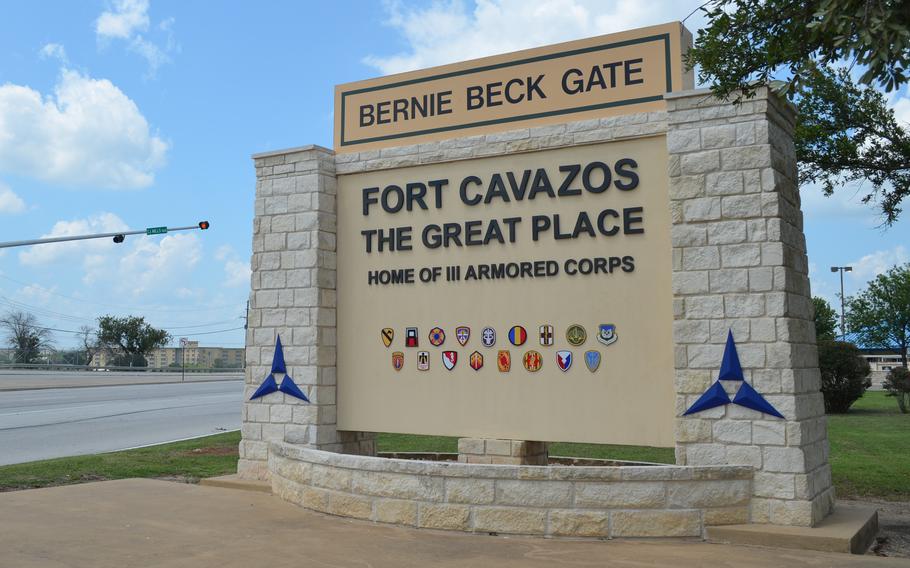
A welcome sign outside Fort Cavazos, Texas. (Rose L. Thayer/Stars and Stripes)
FORT CAVAZOS, Texas — A Fort Cavazos soldier who argued in a preliminary hearing that he acted in self-defense when he shot and killed a fellow soldier along a highway in Texas will face a court-martial, service officials said.
The Army Office of Special Trial Counsel decided last week to charge Spc. Kip D. Holloway, 25, in the death of Spc. Clarence “CJ” White, 26. The general nature of the charges are unpremeditated murder, voluntary manslaughter and aggravated assault, according to Michelle McCaskill, spokeswoman for the special trial counsel.
Both soldiers were assigned to the 2nd Armored Brigade Combat Team of the 1st Cavalry Division, she said. Holloway was a tank crew member, and White was an infantryman.
During a preliminary hearing held April 1, military attorneys discussed 44 pieces of evidence. Maj. Jack Gibson, an attorney with the 1st Cavalry Division, was tasked with reporting to the special trial counsel on whether there was enough evidence to court-martial Holloway and whether prosecutors could sustain a conviction. Gibson recommended the case move forward to a trial, McCaskill said.
“The next step is for a military judge to be assigned to the case and a date scheduled for Spc. Holloway’s arraignment,” she said.
On Jan. 27, 2024, both soldiers, who attorneys said were friends, were driving throughout central Texas in Holloway’s gray Nissan. Holloway was driving, and an intoxicated White was in the passenger seat. White had called and texted Holloway throughout the night to pick him up from a nightclub, according to evidence presented at the hearing in April. His autopsy would later show a blood alcohol content of .216, or nearly three times the legal limit for driving, said Capt. Michael Green, an attorney for Holloway.
At about 6:30 a.m., the two soldiers were pulled over, and White told the police that Holloway was his sergeant bringing him home because he was drunk, said Maj. Tara Goble, a prosecutor in the case.
By about 9 a.m., Holloway called 911 from the side of Interstate Highway 14 in Nolanville to report the shooting. White had a “direct contact” gunshot wound to the head, and Holloway had a “close range” gunshot wound in his right leg, Goble said.
“He tried to kill me,” Holloway said on the 911 recording, which was played during the hearing. “We were in the car fighting for [the gun].”
On the call, Holloway said he shot White after wrestling for control of the weapon, but attorneys disagreed over exactly what Holloway told the operator about his own gunshot wound.
Goble argued Holloway said, “I shot my friend, and I shot myself.”
Green said Holloway’s words were: “I shot my friend, and I’m shot myself.”
No one presented evidence that directly pointed at who shot Holloway, though Goble said only White’s blood was found inside the vehicle. Holloway’s blood is only found on the doorframe leading out of the car. However, White’s DNA was found on the grip and trigger of the firearm, Green said.
Both sides also lacked clear evidence on whether the shooting occurred on the highway while the vehicle was moving or if it happened after the vehicle exited and stopped in a field along the access road. There was no evidence of a struggle in the car, Goble said.
Blood spatter evidence supported that the doors were all closed when White was shot, Goble said. A door was likely open when Holloway was shot, but evidence is not definitive, she said.
In response, Green presented evidence to show White, who was physically larger than his friend, had violent tendencies. White’s medical records stated he told his behavioral health care provider about thoughts of suicide and a need to put his hands on someone, Green said.
He described an instance when White broke his hand and told his unit it happened while putting his niece to bed. Investigators found he broke his hand while he was fighting, Green said.
While the records mentioned White had issues with his boss and other soldiers, there was no mention of problems with Holloway specifically. They could not find “any reason why it would happen,” Green said.
Nolanville, home to about 6,000 people, is roughly 15 miles east of Fort Cavazos. Nolanville police said last year that they gave jurisdiction of the case to the Army.